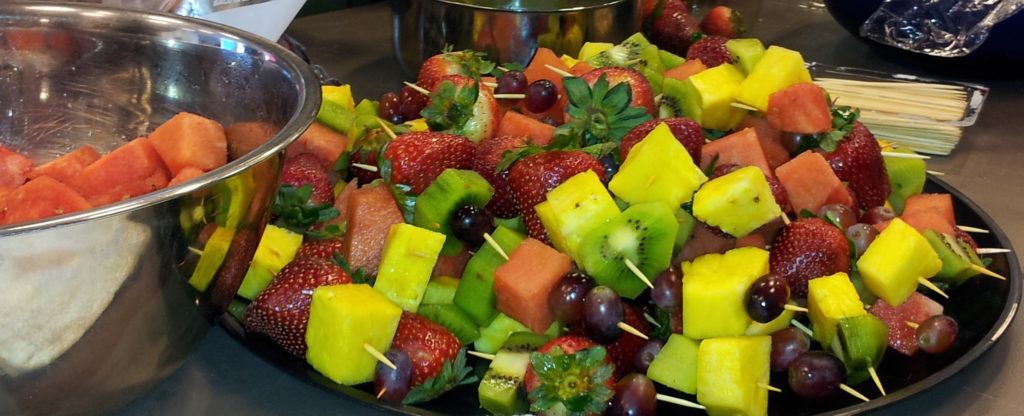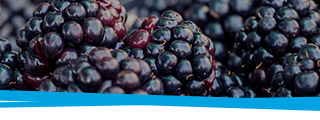
Fruit Kabobs are fun snacks for kids and adults!
What fits easily into a lunch box, tastes great, quenches your thirst, satisfies a sweet tooth and is low in calories? You guessed it – fruit!
Mother Nature has cleverly combined carbohydrates, fiber, vitamins, minerals and, best of all, sweetness, into one colorful package. Fruit consumption is on the rise and now, more than ever, and is recognized as a “fit” food.
Fruit is healthy
Research studies have shown that a daily intake of fruits and vegetables can reduce the risks for chronic diseases, such as heart disease and cancers. The latest Dietary Guidelines for Americans (2015) recommend that we focus on fruit, particularly whole fruit.
These guidelines encourage us to eat a variety of fruit whether fresh, frozen, canned or dried. And, the MyPlate graphic shows us that half of our plate should be fruits and/or vegetables.
Fruit is rich in nutrients
Some may describe fruit as filled with “super powers” because they provide nutrients that are vital for optimal health and maintenance of our bodies. Vitamin C is needed to help our bodies stay healthy and fight against colds and the flu. Fruits that are high in vitamin C include citrus fruits (oranges, clementines, tangerines, grapefruit, lemons, limes), strawberries, pineapple, and kiwi.
Vitamin A, or beta-carotene, is another nutrient found in fruit and it helps our eyesight. It acts as an anti-oxidant and may reduce our risk for eye problems. Fruits that are orange in color, such as apricots, cantaloupe, red or pink grapefruit, papaya, and mango, are high in vitamin A.
Fruits are also high in a soluble fiber, called pectin. Pectin helps to lower blood cholesterol levels and makes you feel full longer. Fruits highest in this type of fiber include apples, blackberries, raspberries, and pears.
On the sweeter side
Fruits are naturally high in two simple sugars; glucose and fructose. These natural sugars can help satisfy that end of a meal craving for a sweet dessert, without a calorie overload. Fruits are low in fat, low in sodium and relatively low in calories, so they can help maintain a healthy weight.
When shopping for fruits, think about the colors of the rainbow. Choose lots of different colors (red, orange, green and purple) to assure that you are getting a variety of nutrients that your body needs. Buying an assortment of fresh, frozen, canned and dried fruits will assure that fruit is always available for you and your family.
Here are my favorite ways to make my diet a fruitful one:
- At breakfast, top your cereal with sliced bananas, blueberries, peaches or strawberries. Heat blueberries or strawberries and serve them over pancakes. Add fruit, such as applesauce, to muffins and cut the amount of sugar in half. Make a fruit parfait by layering low-fat plain yogurt with your favorite fruits. Create a smoothie by blending low-fat yogurt with frozen fruit.
- At lunch, pack an orange, banana or grapes to energize you through the afternoon. Add fruit to cottage cheese for a refreshing salad.
- At dinner, use fruit to tenderize meats and flavor entrees like chicken with apricots. Add fruit to salads like mandarin oranges on spinach salad and crushed pineapple with coleslaw. Try colorful fruit kabobs to add eye appeal to your barbecue. For dessert, try baked apples, poached pears or a fresh fruit salad.
- Keep a bowl of whole fruit on the table, counter or in the refrigerator for healthy eating on the run. Dried fruit makes great, grab n’ go snacks, or spread apple slices with peanut butter.
March is National Nutrition Month, and this year’s theme is “Put Your Best Fork Forward.” Let’s all put our forks into fruits. Fruits should be enjoyed as part of our daily diets – they are sweet and swell for you!
- ‘Tis The Season For Fresh Produce! - August 6, 2018
- Low-Cost, Healthy Summer Activities for the Family - June 5, 2018
- Winter is Soup Season - February 11, 2018


